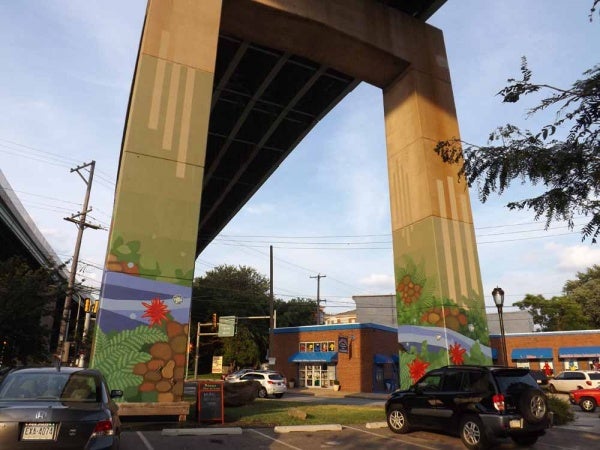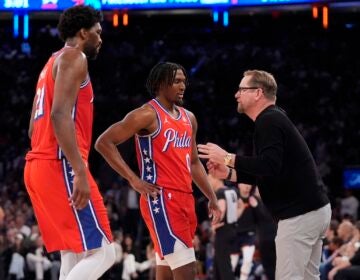East Falls Tapestry speaks to the identity and ‘industrial heritage’ of the neighborhood
“Am I in the right place?”
That was the comment from Philadelphia’s Fourth District Councilman Curtis Jones, Jr., who attended the dedication ceremony for the new “East Falls Tapestry” mural yesterday evening. He says the area under the Twin Bridges, located on Ridge Avenue under Route 1, has gone through a “transformation.”
“What a difference some TLC can make. It’s tranquil here,” said Jones.
The mural features fish “swimming up the columns” that support Route 1. The design was inspired by a Japanese kimono that is a part of Philadelphia University’s fabric collection. Woven into the garment are Koi fish that were reinterpreted in the design to represent the fish and water of the Schuylkill and the former East Falls waterfall.
With the history of East Falls in mind, the use of a garment as inspiration speaks to the textile manufacturing industry that was a key part of the area during the Industrial Revolution, with nearby Dobson Mills as a primary manufacturer.
Gina Snyder, president of the East Falls Development Corporation (EFDC), says the space under the Twin Bridges needed to be more “connected to the business corridor” and that having the mural there would help to tie each side of the bridge together.
“This project was a very long process. We’ve waited a couple of years for this, we’re so happy it’s happening today,” said Snyder.
Jane Golden, executive director of Philadelphia’s Mural Arts Program, says the project was about five years in-the-making.
“Sometimes great things take a long time, but we did it! It’s really a renaissance,” said Golden, “the city is alive with art. We are on a mission to make sure everyone, everywhere, has access to art and beauty, and therefore, hope.”
Out with the old, in with the new
The spot that now houses the mural was once home to another mural that paid homage to the Olympics with images of rowers, boxers and other athletes.
“They were no longer attractive and the paint was flaking off of them,” said Snyder.
Carla Bednar, who is a member of the voting committee for the project, says the entire area under the bridge used to be a “concrete jungle” with overgrown weeds. Now, the area is home to a sustainable parking lot and the new mural.
Ellen Sheehan, president of the East Falls Historical Society, says she’s thrilled the mural represents part of the East Fall identity.
“My family has lived in this area since the late 1700s,” said Sheehan, who added that the mainstay meal of the area was a catfish and waffle dinner.
She also remembers the waterfall that the neighborhood is named for.
“This is a great spot for it because this is where the waterfall used to be,” said Sheehan. “You used to be able to hear the falls.
A design that fits the neighborhood’s identity
Two artists, Mike Smash and Johnny Buss, were chosen to work on this project.
Buss says he didn’t know how large-scale the project would be, or how passionate the community was about it, when he initially applied for the job.
“They made us care,” said Buss, “everyone that passes by says how great it is.”
The project’s design was put together with input from the community in mind. Snyder says the EFDC put up displays around the neighborhood for people to contribute their opinions.
After about five projects were pitched to a committee of 10 East Falls residents, the group voted on the Japanese kimono-inspired design.
The kimono is part of Philadelphia University’s textile collection and a favorite of Bednar’s, who had the idea to use it for the project. She previously worked for 10 years as an assistant director at the school’s Design Center.
“We wanted something that is a part of our identity,” said Bednar, who says they call it a “waterfall kimono.”
Mike Leonard, interim academic dean at Philadelphia University, says the school was glad to lend the kimono.
“It’s part of a collection of Asian-inspired pieces that date back over a century. This piece in particular has always been a show stopper. You tend to study it as an artifact,” said Leonard. “Now, it represents part of our industrial heritage.”
WHYY is your source for fact-based, in-depth journalism and information. As a nonprofit organization, we rely on financial support from readers like you. Please give today.










